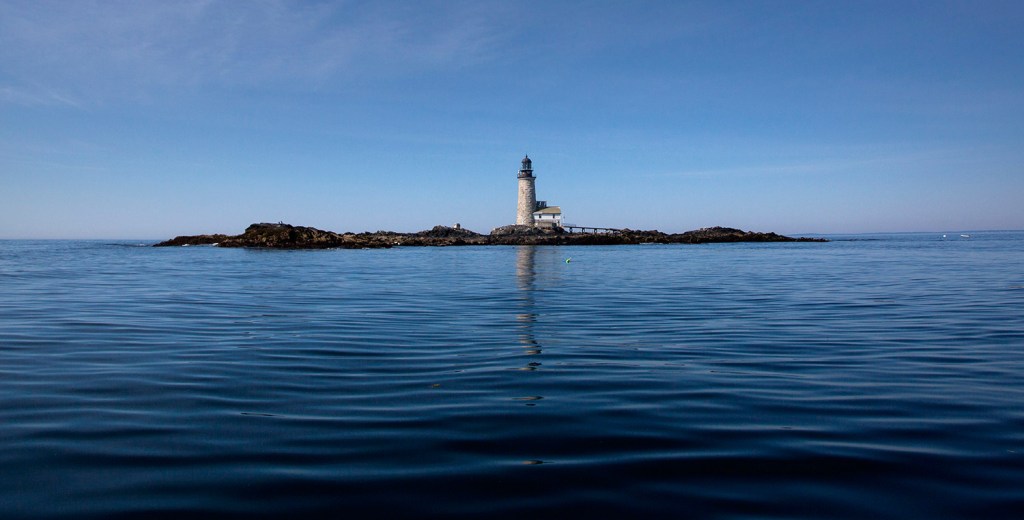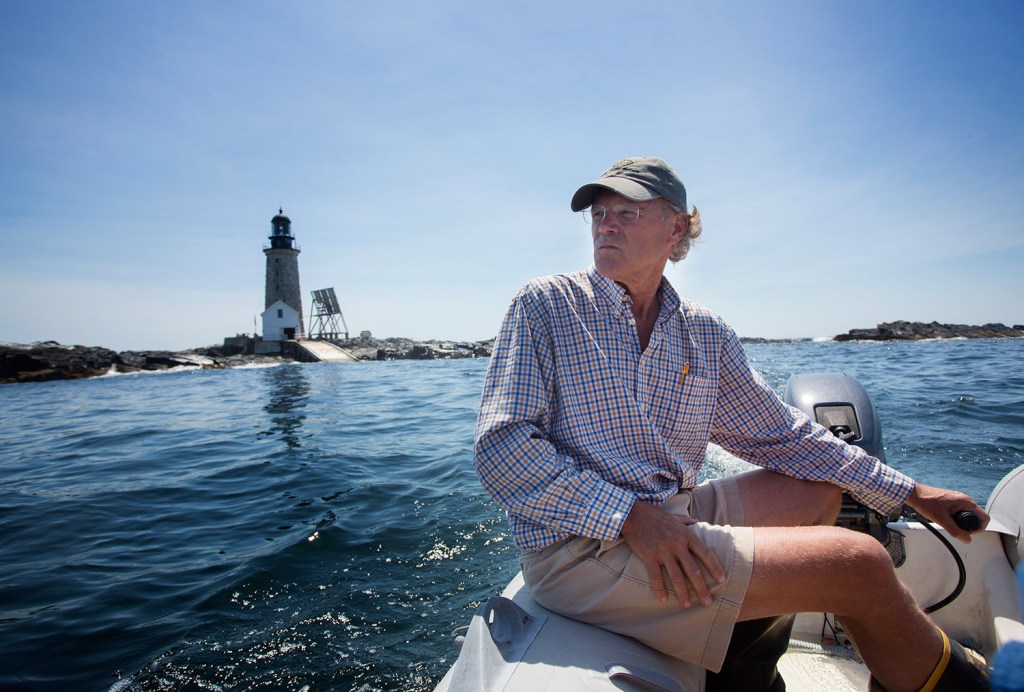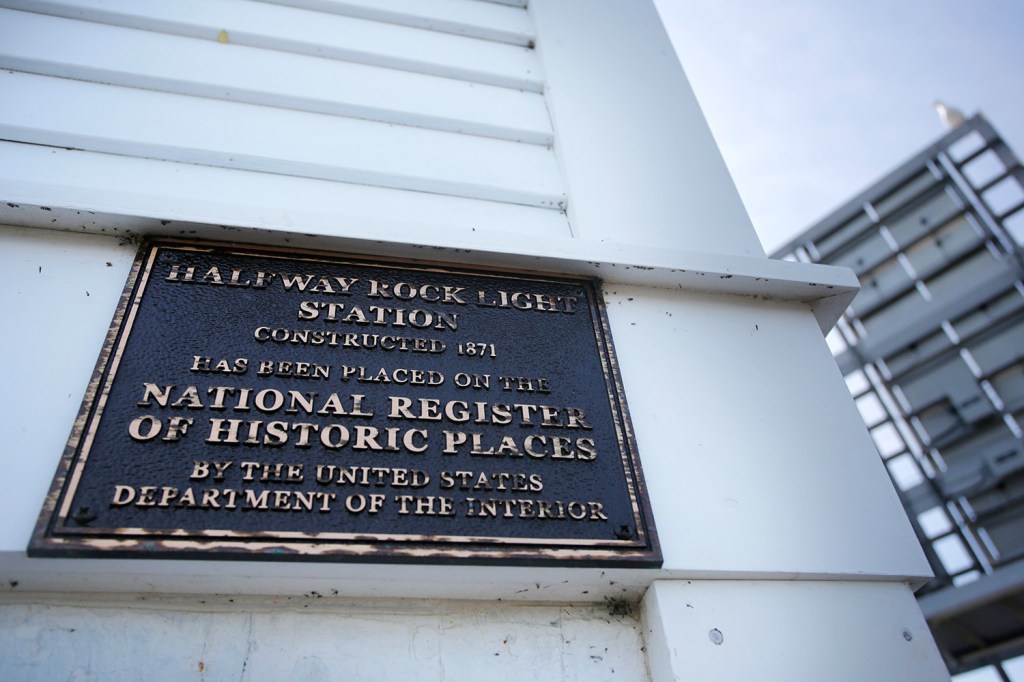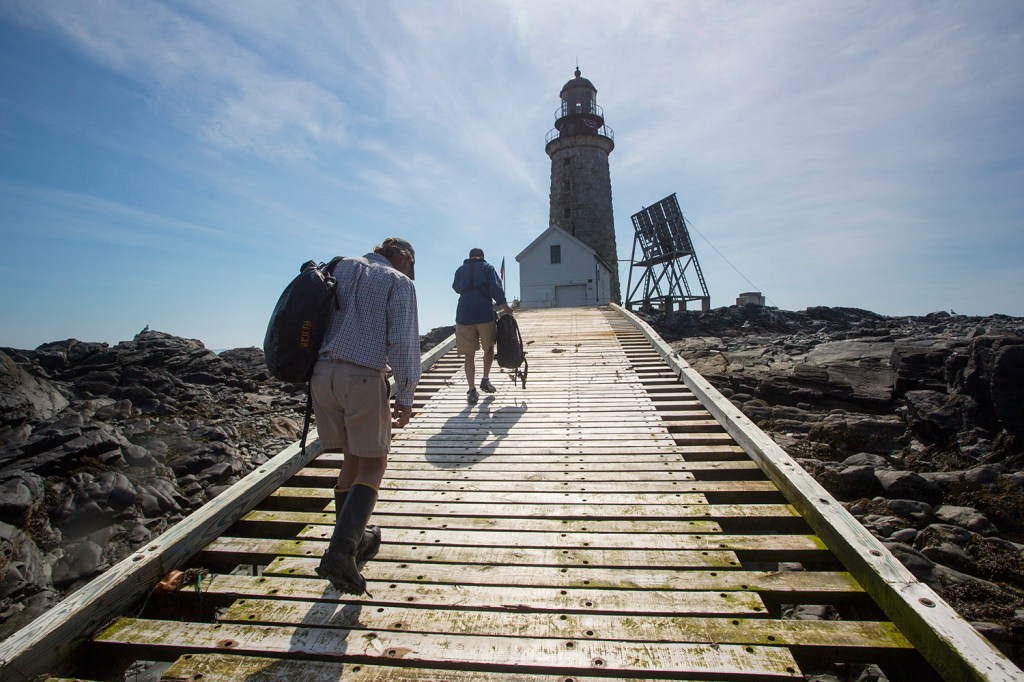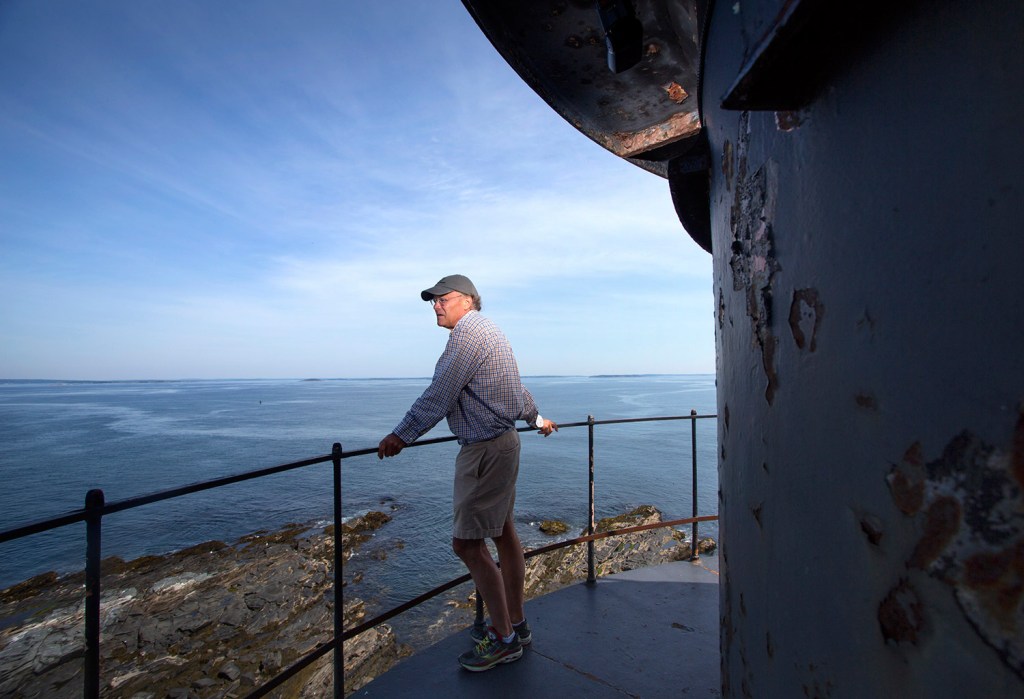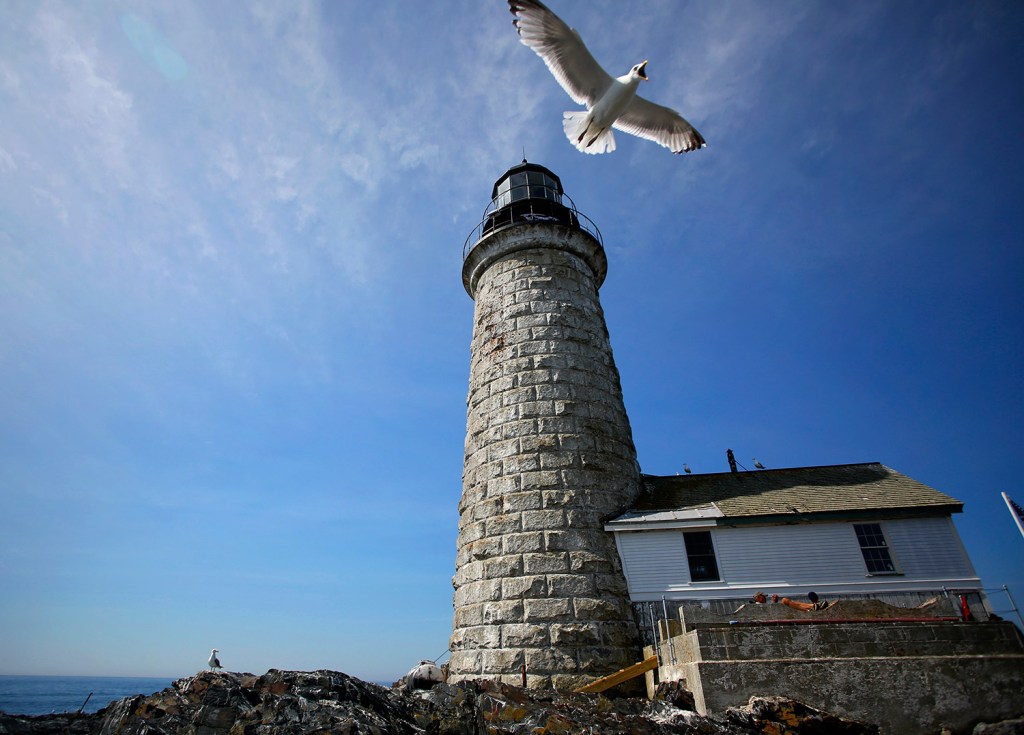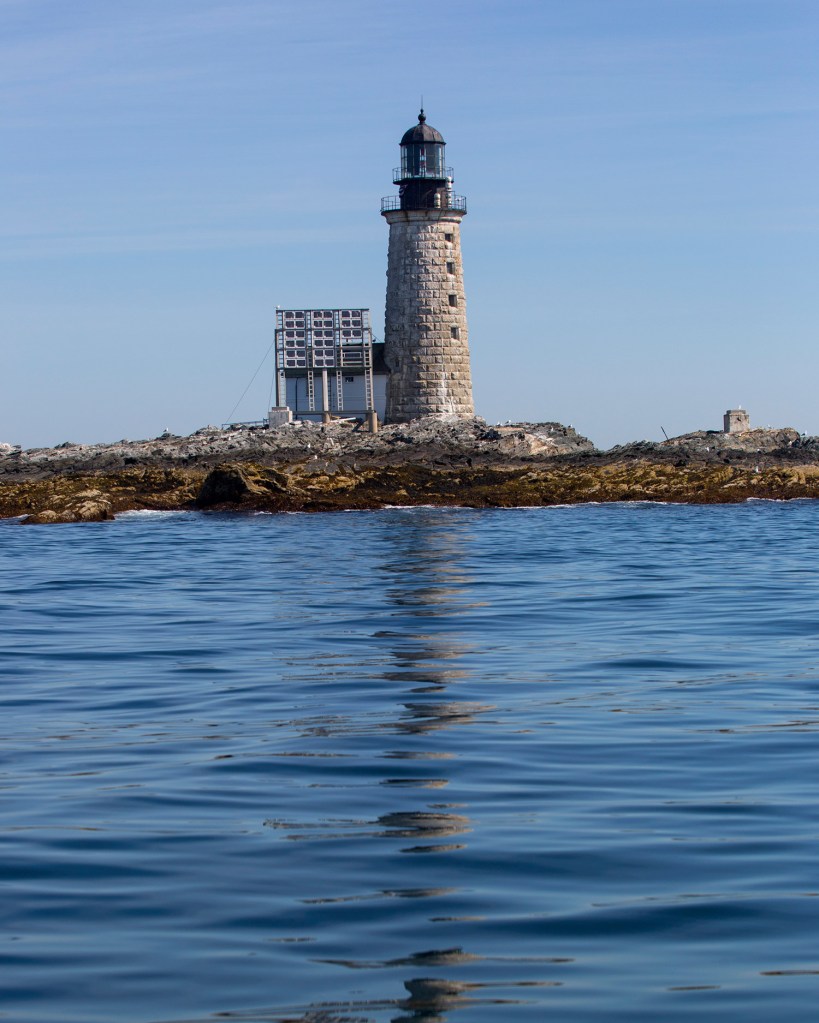HALFWAY ROCK — History records how one of the earliest keepers at Halfway Rock Lighthouse was driven nearly insane by the isolation of living on a two-acre rock ledge, more than 4 miles off the tip of Harpswell. He refused to speak to his assistant for up to 10 days at a time and after being deemed a safety risk, was forced to resign his duties. That was in 1883.
Stories like this resonate with Ford Reiche, who bought Casco Bay’s most remote lighthouse at government auction in 2014.
“You can’t be here and not imagine what it was like,” he said last week, standing outside on the gallery, the railed balcony ringing the 76-foot-high granite tower.
Halfway Rock Lighthouse was abandoned by the Coast Guard in 1975. No preservation group or agency had the resources to take over, and it was put up for auction. Reiche paid $283,000, the highest price ever paid for a Maine lighthouse.
But this wasn’t about vanity or bucket lists. Reiche, who ran a successful rail-to-truck transfer business in Auburn and is active in historic preservation, bought Halfway Rock Lighthouse to restore a maritime landmark once listed as one of Maine’s 10 most endangered historic properties. He has spent the past year just trying to counter four decades of extreme weather that has smashed in windows and walls and washed away the dock.
This would be a complicated and expensive undertaking, even if the tower and its wooden boathouse were close to shore in sheltered waters. But Halfway Rock, located on the fringe of Casco Bay halfway between Small Point in Phippsburg and Cape Elizabeth, is what’s known as a wave-swept lighthouse. The ledge is frequently submerged. A surging sea constantly nips at the perimeter from all directions. In violent storms, monster waves 60 feet high can pummel the rock.
Access is always difficult and sometimes impossible. And save for the stone tower, almost everything built here since the lighthouse was commissioned in 1871 has been destroyed or carried away by the relentless sea. A helicopter pad built in 1960 lasted only one year. Today it’s a patch of broken pavement strewn with boulders.

A HUMBLING EXPERIENCE
So why do it?
Reiche doesn’t have a media-savvy sound bite. The question makes him introspective. He says, finally, that it’s the essence of historic preservation to see value in icons of the past and want to give them life for the future. Saving Halfway Rock Lighthouse, he says, is just something that needed doing and he has the skills and resources to do it.
Reiche is 62 and grew up in Falmouth. He lives in Cumberland and has sailed most of his life. He co-founded and has since sold Safe Handling, a transportation logistics company that moved and warehoused billions of pounds of material. He’s a trustee of Maine Preservation and has restored historic homes and a railroad station in western Maine.
But tackling Halfway Rock has been a humbling experience.
Two small skiffs and their outboard motors already have been damaged beyond repair by the ceaseless swells. To safely make the 10-mile transit from his marina in Freeport, Reiche purchased a 25-foot Safe Boats International Defender-class vessel at a Coast Guard auction. With its reinforced aluminum hull and enclosed pilothouse, the military-grade responder boat can cruise at more than 40 mph and slice through scary seas.
Even so, sometimes Reiche and a work crew arrive at the rock to find that it’s just too dangerous to get from the mooring onto the landing ramp in a 10-foot inflatable. That reality hit home last year, when a wave almost flipped the inflatable as Reiche approached the ramp. He lost some gear, and gained a new appreciation for the hazards of his undertaking.
But then there are the calm, clear nights, like this past July Fourth. Atop the lighthouse with family and friends, Reiche watched fireworks displays from Boothbay Harbor to the east, Old Orchard Beach to the south and Sebago Lake inland.
“We stopped counting at 31 towns,” he says.
EVIDENCE OF A STORMY HISTORY
On a recent morning, the sun was out, the sea was calm and Halfway Rock was a magical place, as Reiche and a workman arrived on the ledge.
Gulls protecting their chicks screamed and swirled above the human intruders. Their apprehension was not shared by the dozens of seals hauled out on the rocks at low tide, who lounged unfazed. Boat wakes parted the dazzling water, as lobster fishermen worked their traps. The hum of boat motors blended with the splash of surf breaking over the rocks, punctuated every 30 seconds by the groaning foghorn.
Conditions were quite different during a storm in March of 1958, captured by Coast Guard keepers. The log is titled “Record of the Miscellaneous Events of the Day,” although they are anything but routine.
“0900: 60-foot waves washing over island, fog signal casualty, checked and repaired. Two 50-gallon drums of lubricating oil and one 50-gallon drum of diesel oil with rack washed overboard. Recovered lubricating oil but lost fuel oil. Rack was demolished. Winds 75 miles per hour.”
“1230: Heavy frontal waves smashed concrete, being lifted and moved away from house. Porch on east side of slip gave way, boat slip boards pulled up, slip is twisting and bending. One brace cut in half, iron slightly lifted. Window on exposed Navy watch tower demolished.”
Reiche loves discovering these historic footnotes that give his lighthouse life.
A generation of keepers was stunned when word came that the U.S. Lighthouse Service, which oversaw lighthouses and lightships, was to be disbanded in 1939, and folded into the Coast Guard. That may have led two keepers to break strict rules and bring a bottle of whiskey to Halfway Rock to celebrate New Year’s Eve. Reiche and his work crew found that bottle last year, hidden inside a wall they were renovating. It was signed and dated by the keepers.
‘FORD WAS ITS LAST HOPE, REALLY’
Halfway Rock Lighthouse is listed on the National Register of Historic Places. Reiche is restoring the keepers quarters inside the tower and the attached wooden boathouse, galley and bedrooms to what they looked like in the 1950s. He has pulled the walls back to their Douglas fir paneling, creating a cozy kitchen and eating area, made weather-tight with new windows and warmed by a Queen Atlantic wood range. The materials and construction techniques used to achieve this period of interpretation, as it’s called, are scrutinized by the Maine Historic Preservation Commission.
Reiche, who wouldn’t disclose how much he’s spending on repairs and restoration, stepped up at a critical time, according to Bob Trapani, executive director of the American Lighthouse Foundation in Owls Head. The breached boathouse eventually would have been swept away, he says, along with what remained of the ramp.
“Ford was its last hope, really,” Trapani says. “No one would do what he’s doing. Thirty years from now, this will be seen as a historic moment.”
While much work remains, Reiche has already accomplished a lot. One of his biggest victories was securing clear ownership of Halfway Rock. A title search found it hadn’t been properly conveyed to the federal government. It took a special act of the Maine Legislature to make things right.
Reiche hopes to spend more time here with family and friends this summer, while he chips away at his to-do list. He plans to have solar-electric panels installed, to power lights and appliances. A webcam also is in the works.
He’s especially proud of the 150-foot dock and ramp, which took all last summer to construct. He figures that access point has been rebuilt more than a dozen times and is symbolic of the ongoing struggle to keep a human presence on a weather-beaten ledge in the middle of Casco Bay for 145 years.
“I have a healthy attitude about that dock,” he says. “There’s no way it could have been built any stronger. But if it washes away, we’ll build a new one.”
Send questions/comments to the editors.


